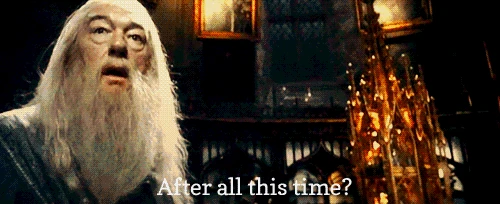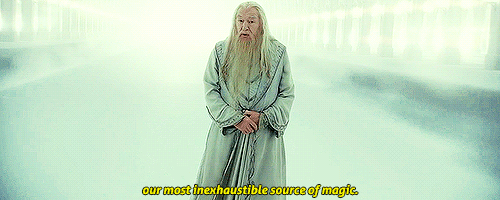The Lost Love of Dumbledore and Grindelwald
The most powerful form of magic in the Harry Potter universe is love. Love was the power that let baby Harry survive Voldemort’s curse against all odds. Love was the fire that burned Quirrell’s hands when he tried to lay them on Harry’s skin. Love was the shield engulfing all of Harry’s friends and allies when he sacrificed himself to protect them at the end of Deathly Hallows.
For reasons even Unspeakables in the Department of Mysteries can’t comprehend, love has a profound effect on magic, and Rowling demonstrated its power through the variety of loving relationships portrayed throughout the series. Mothers with their hearts full of love sacrificed themselves for their children time and time again, love between friends gave Harry the happy memories he needed to conjure his Patronus, and the role of romantic love grew in importance as Harry and his friends matured.
We saw a multitude of romantic relationships rise and fall throughout the Potter series, but not a single one of them represented the love shared in a non-heterosexual relationship. Rowling told fans she had always considered Dumbledore gay after Deathly Hallows was released, but depending on which side of the canon fence you sit on, the inclusion of LGBT characters in the Potter saga may not even be canonical. Within the text, the only known LGBT relationship is never explicitly identified as being romantic.
Some people argue that you could have guessed Dumbledore’s sexual orientation because there were little hints of it throughout the books; Dumbledore’s colorful wardrobe and Rita Skeeter’s scathing commentary on his relationship with Harry in Deathly Hallows are often cited as pieces of such evidence. These are flimsy claims at best and based on stereotypes of gay men as flamboyant and predatory. Dumbledore’s vague descriptions of his relationship with Grindelwald might be more of a clue, but nothing he says is enough to guarantee their relationship was anything but platonic.
Others claim that the book was so long, there was no room to include Dumbledore and Grindelwald’s romance. After all, their relationship took place decades before Harry’s story began. Understanding Dumbledore’s character as a whole requires a lot of reading between the lines, and his relationship with Grindelwald was just another place where the audience needed to read a little more carefully to get the full story.
The thing is, it wouldn’t have taken much more text to include Dumbledore’s relationship with Grindelwald in the story. I’m not asking for “The Prince’s Tale” level of detail, just a sentence or a few words. There were plenty of opportunities. Aberforth, Auntie Muriel, Elphias Doge, and Rita Skeeter all could have said something. Dumbledore himself could have mentioned it while he was talking about Grindelwald at King’s Cross. Dumbledore was the champion of love throughout the novels; is it not important that his defeat of one of the Darkest wizards of all time was also the defeat of his former lover? The book may be long, but is it too long for just a few more words?
No matter why it was never mentioned, the exclusion of Dumbledore’s relationship with Grindelwald puts the Potter series on a long list of stories that fail to include the experiences of LGBT characters within their text. There was never an appropriate time to mention their romantic story, and many LGBT individuals in the Muggle world never find an appropriate time to share theirs.
There will never be an appropriate time for the inclusion of LGBT experiences if we continue to put alternative sexualities out of sight. If we want to keep making the world a safer place for LGBT individuals, storytellers of all kinds need to give their LGBT characters an opportunity to share themselves. If storytellers share the love stories of their LGBT characters, maybe one day the real world will be a safe place for LGBT individuals to share their love as well.




